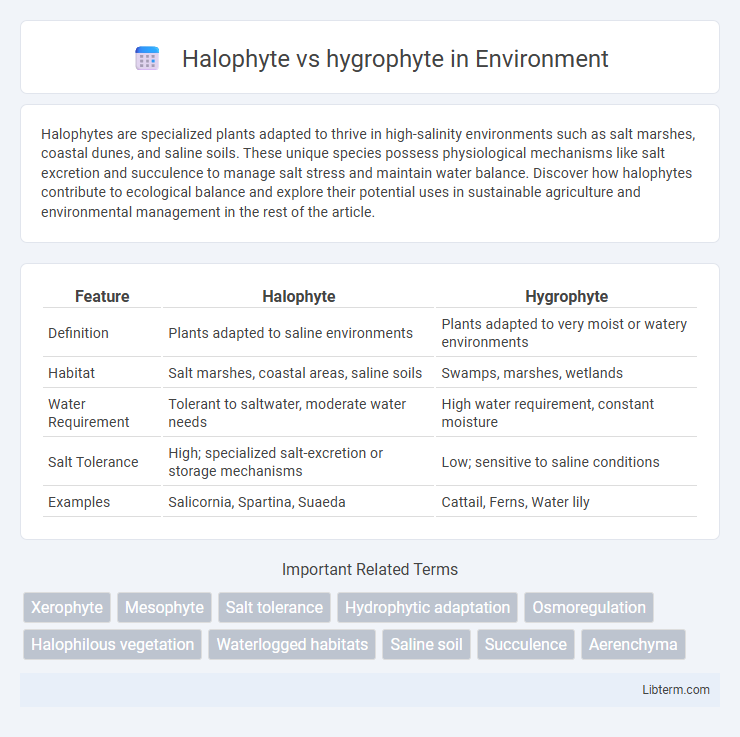Halophytes are specialized plants adapted to thrive in high-salinity environments such as salt marshes, coastal dunes, and saline soils. These unique species possess physiological mechanisms like salt excretion and succulence to manage salt stress and maintain water balance. Discover how halophytes contribute to ecological balance and explore their potential uses in sustainable agriculture and environmental management in the rest of the article.
Table of Comparison
| Feature | Halophyte | Hygrophyte |
|---|---|---|
| Definition | Plants adapted to saline environments | Plants adapted to very moist or watery environments |
| Habitat | Salt marshes, coastal areas, saline soils | Swamps, marshes, wetlands |
| Water Requirement | Tolerant to saltwater, moderate water needs | High water requirement, constant moisture |
| Salt Tolerance | High; specialized salt-excretion or storage mechanisms | Low; sensitive to saline conditions |
| Examples | Salicornia, Spartina, Suaeda | Cattail, Ferns, Water lily |
Introduction to Halophytes and Hygrophytes
Halophytes are specialized plants adapted to thrive in saline environments such as salt marshes and coastal areas, exhibiting physiological mechanisms like salt excretion and succulence to manage salt stress. Hygrophytes, in contrast, are plants that prefer or require high moisture conditions, often found in wetlands and rainforests, with adaptations like large, thin leaves to maximize transpiration and water absorption. Both plant types demonstrate unique ecological strategies to optimize survival in extreme moisture-related habitats.
Defining Halophytes: Key Characteristics
Halophytes are plants adapted to thrive in saline environments, such as coastal marshes and salt flats, exhibiting specialized salt tolerance mechanisms like salt excretion and succulence. They possess physiological traits including salt ion compartmentalization in vacuoles and osmotic adjustment to maintain cellular function under high salinity. Halophytes contrast with hygrophytes, which are adapted to freshwater, water-saturated habitats and lack salt tolerance capabilities.
Understanding Hygrophytes: Main Features
Hygrophytes are plants adapted to thrive in environments with abundant water, such as marshes and swamps, characterized by thin cuticles, large stomata, and extensive aerenchyma to facilitate gas exchange and water regulation. These plants exhibit large, often broad leaves to maximize transpiration and effectively manage excess moisture. Unlike halophytes, which are specialized for saline conditions, hygrophytes require consistently moist, freshwater habitats for optimal growth and survival.
Habitat Differences: Saline vs Moist Environments
Halophytes thrive in saline environments such as salt marshes, coastal areas, and salt flats, demonstrating specialized adaptations for high salt tolerance. In contrast, hygrophytes inhabit consistently moist or waterlogged habitats like swamps, wetlands, and riverbanks, where abundant water availability is critical for their growth. These habitat differences shape their physiological mechanisms, with halophytes managing salt stress and hygrophytes optimizing water uptake in saturated soils.
Adaptations in Halophytes
Halophytes exhibit specialized adaptations such as salt secretion glands, succulent leaves for salt dilution, and osmotic adjustment through ion compartmentalization to survive high-salinity environments. These plants possess thick cuticles and reduced stomatal density to minimize water loss and maintain cellular turgor under osmotic stress. Their root systems are often highly selective, enabling efficient water uptake while excluding excessive salt ions.
Adaptations in Hygrophytes
Hygrophytes exhibit adaptations such as large, thin leaves with a high stomatal density to facilitate efficient transpiration in water-abundant environments. Their tissues often possess poorly developed cuticles and air spaces that aid in oxygen diffusion within saturated soils. These structural features optimize water absorption and gas exchange, enabling survival in consistently moist or aquatic habitats.
Ecological Roles and Importance
Halophytes play a crucial ecological role in saline environments by stabilizing soils, reducing erosion, and providing habitat for salt-tolerant wildlife, contributing to the biodiversity of coastal and desert ecosystems. Hygrophytes are essential in freshwater and moist habitats, facilitating nutrient cycling, maintaining hydrological balance, and supporting diverse aquatic and terrestrial species. Both plant types are vital for ecosystem resilience and adaptive capacity in their respective environments, promoting sustainable ecological functions amidst varying water and salinity conditions.
Examples of Halophyte Species
Halophytes such as Salicornia europaea, Spartina alterniflora, and Atriplex species thrive in high-salinity environments like salt marshes and coastal areas by adapting specialized salt excretion mechanisms. These salt-tolerant plants contrast with hygrophytes, which prefer consistently moist, freshwater habitats and include species like ferns and cattails. The ecological role of halophytes includes stabilizing saline soils and supporting unique coastal ecosystems.
Examples of Hygrophyte Species
Hygrophytes are plants adapted to thrive in moist or water-saturated environments, such as marshes, swamps, and wetlands. Common examples of hygrophyte species include the water lily (Nymphaea spp.), cattail (Typha spp.), and marsh marigold (Caltha palustris), all exhibiting specialized adaptations to cope with excess water. Unlike halophytes, which tolerate high salinity, hygrophytes require abundant freshwater and are poorly adapted to saline conditions.
Comparative Analysis: Halophytes vs Hygrophytes
Halophytes thrive in saline environments by developing specialized salt-excreting glands and succulent leaves to manage osmotic stress, whereas hygrophytes depend on high soil moisture and exhibit thin cuticles with large stomata to optimize water intake. Halophytes show biochemical adaptations such as elevated proline and glycine betaine levels to combat ion toxicity, contrasting with hygrophytes that maintain constant hydration through morphological traits like extensive root systems for water absorption. The ecological distribution of halophytes is predominantly in coastal salt marshes and saline deserts, while hygrophytes dominate wetlands and rainforests with abundant freshwater availability.
Halophyte Infographic

 libterm.com
libterm.com